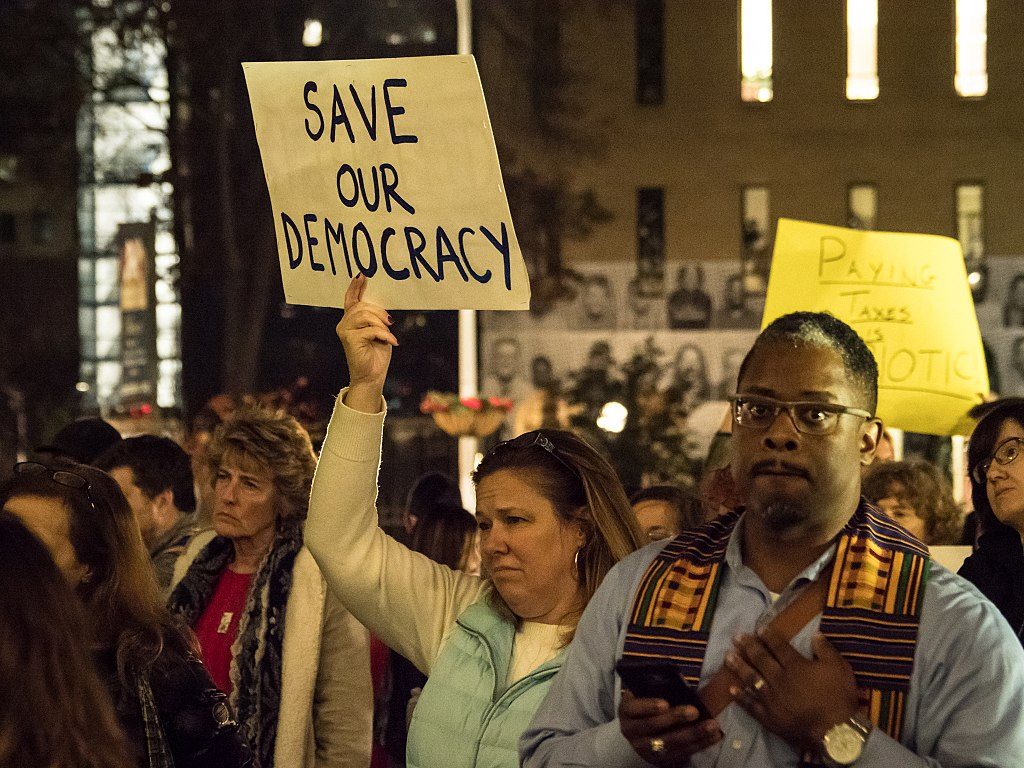
As American democracy descends further into its present impasse — or abyss — we can trace the steps by which we have arrived at our unhappy moment. There’s never been a time when our politics hasn’t been a blood sport, and the wrangling for power among the Founding Fathers, including a fatal duel, was second to none. It needs, too, to be remembered that we were not given a democratic constitution at the beginning but a republican one, in which a majority of the adult population, both women and slaves, lacked many where not all rights, including suffrage, and the upper house of Congress was elected not by direct popular vote but by state legislatures. As for the lower one, gerrymandering distorted electoral results as early as 1812. Finally, the Electoral College made it possible for both the president and the vice president to be chosen by a minority of even the minority entitled to vote, and by 1824 this had occurred with John Quincy Adams’ victory over Andrew Jackson.
The right to vote was gradually extended to those originally excluded, although it took a civil war that cost 700,000 lives to (theoretically) enfranchise black males, and over a half century more to include women. Inclusion immediately generated suppression; it was not until the last third of the twentieth century that African Americans in the South could vote as a practical matter except at the risk of their lives. Since actual mass murder would not do, poll taxes were the mechanism of choice for minority suppression, and when these were gradually outlawed they were replaced by the more cumbersome but ultimately quite profitable system of mass incarceration, which, with associated lifetime bans in many states on voting by ex-felons, have produced the same result. Such bans are still in force in many places.
It was only with Abraham Lincoln’s formula of government as a thing of, for and by the people that democracy gained footing on an even theoretical level. It was a long way from reality when he pronounced it at Gettysburg in 1863; it has been a battle ever since. Actual control of the levers of government belonged, at first, largely to a slave-owning aristocracy, and, after the Civil War, to a business class that no less effectively dominated the political process by its control of the economic one. Nonetheless, the struggle for popular democracy continued, as trust-busting replaced abolitionism as the primary locus of struggle.
It was the patrician Franklin D. Roosevelt who gave democracy its second wind during the Great Depression, although his consolidation of executive power in the Second World War laid the foundations for the imperial presidency that besets us now. A last pushback against this in the 1970s fell lamentably and predictably short, and a combination of voter suppression and manipulation of the Electoral College has given us two minority presidencies among our last three, both unapologetically wedded to business interests. But a more formal strategy for a minocracy, as I will term rule by a minority, emerged around the same time with the now infamous memorandum of Lewis Powell, the later Supreme Court justice, which outlined a strategy for permanent governance by the Republican Party, the preferred political vehicle of business interests. It involved dominance of the executive and the court system, and the gradual neutering of Congress, designed by the Founding Fathers as the chief instrument of government. Voter suppression, gerrymandering and the undemocratic nature of the U.S. Senate, half of whose seats come from states representing only 18 percent of the population, have helped a demographic minority control Congress, and gridlock politics, rigorously applied over the past quarter century, has done much of the rest. The spigot of corporate money opened by the Supreme Court’s decision eight years ago in Citizens United institutionalized our practical Constitution of today: government of, by and for business.
The election of Donald Trump as president in 2016 has opened yet another chapter of democratic decline. Trump leapfrogged over the party system to create his own political constituency, generally referred to as the “base,” substantially comprised of angry white voters kept at a boil by incendiary rallies that bear no small resemblance to those of fascism and devoted to the bizarre cult of personality Trump fostered while campaigning and has perfected in office. Politicians were supposed to be responsive to the wishes of their constituents; with Trump, they are terrified of them, and not on the Republican side alone. But Trump is of course no populist, and the prime beneficiary of his shenanigans remains the business class, including his personal empire. In practical terms, his presidency has been an extension of that of George W. Bush, with business-dictated tax cuts and partisan packing of the courts. Nonetheless, it represents a further erosion of democracy, and the opening of a demagogic politics that has paved the road for actual tyranny. Presidents used to pay a price for lying, personal profiteering and the abuse of power in office. Trump has openly relished these displays, and redefined them for his base—and for much of a numbed public beyond it—as normative and even gratifying. This, too, is how tyranny comes.
We are at a turning-point in our long national history, and we will have to decide who and what we are. That has been the challenge of democracy from the beginning. The hope cannot lie in any reform of the established system by itself. It must come, as democracy always does, from the body of the people itself. If that fails, then the age of Caesars truly begins. And you won’t like it one bit.

